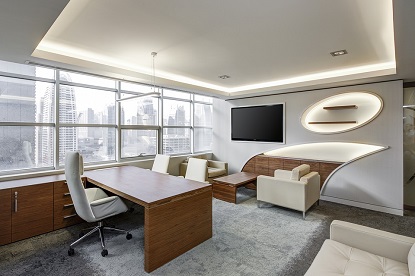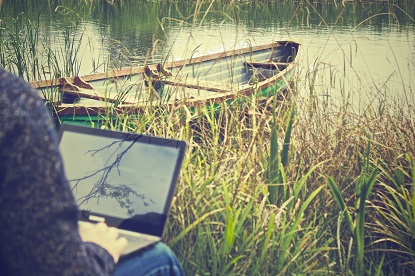What Does the Workplace of the Future Look Like?


If a thirty-something working professional from today was dropped into an office in 1980, they’d likely go into shock. No computers, no Wi-Fi—no Internet at all. All information was stored in hulking metal file cabinets, all contacts were listed in a Rolodex and creating a document meant grabbing a stack of paper, a 15-pound typewriter, a dictionary and plenty of Wite-Out. The day ended at 5 p.m. sharp, suits were required and telecommuting was a privilege reserved for international executives.
 But while this archaic work style seems ludicrous by today’s standards, the workplace of the future will be nearly as unrecognizable. A lot can happen in 35 years, and technology evolves exponentially.
But while this archaic work style seems ludicrous by today’s standards, the workplace of the future will be nearly as unrecognizable. A lot can happen in 35 years, and technology evolves exponentially.
Today we’re going to take a look at what work life will resemble in the not-so-distant future, and how business leaders should prepare for the next few decades.
No More 9-to-5
For several generations, work has been referred to as a place where you go more than something you do. The office has long remained the hub of a business, a space where employees gather for several hours each day and commit to individual tasks. While this concept of the 9-to-5 workday is still largely popular, attitudes are changing.
According to a 2014 survey by Bentley University, 77 percent of Millennials surveyed said flexible hours would make the workplace more productive. Additionally, scientific evidence shows some people are naturally early risers while others focus better at night. In other words, if you want your employees at their sharpest while they’re working, you may need to let go of the traditional workday. In 30 years, this arrangement may not even exist.
Instead of forcing your night owls to become early birds, or vice versa, provide them a choice. Consider offering two shifts: one that begins early in the morning and one that begins later in the day. Or do away with shifts altogether and allow employees to work the  hours best suited to their circadian rhythm and lifestyle.
hours best suited to their circadian rhythm and lifestyle.
The Internet of Everything
In the past few years, technology specialists, social scientists and business leaders have speculated how the Internet of Things will affect work life. The growth of big data has already shown us some of the benefits of connected devices, but what will this look like in 10, 20 or 30 years?
One major change will be the importance of devices and the intersection of technology and security. “It will not be the watch on your wrist or the phone in your pocket,” says Charles M. Lieber, professor of Chemistry at Harvard University. “Your ‘device’ will be your digital identity, used like a key to enter the system from any number of screens and actions.”
The Internet of Things has the ability to help us work faster, smarter and personalize our work experience. From reminding us it’s time for a break to automatically adjusting the light and temperature of the room for maximum productivity, we’ll see IoT play a major role in the ideal workspace of the future.
Work From Anywhere
 In 10 years, telecommuting has transitioned from a rare perk to a standard benefit. Many of today’s professionals work from home offices, coffee shops, airplanes, hotels and nearly anywhere with a chair and a Wi-Fi connection. Recently, we’ve witnessed a surge of coworking spaces—or, open offices where freelancers, remote workers and entrepreneurs pay a membership to utilize shared office space and services.
In 10 years, telecommuting has transitioned from a rare perk to a standard benefit. Many of today’s professionals work from home offices, coffee shops, airplanes, hotels and nearly anywhere with a chair and a Wi-Fi connection. Recently, we’ve witnessed a surge of coworking spaces—or, open offices where freelancers, remote workers and entrepreneurs pay a membership to utilize shared office space and services.
According to the Boston Business Journal, the number of coworking spaces has rose 83 percent between 2012 and 2013 alone. Thanks to growing sophistication of tools like video conferencing, collaboration software and other communication enabling technology, by the year 2050, hardly anyone will be working out of a traditional office.
Setting up a well-planned work-from-home process not only will help your workforce adjust to this trend, but it also widens your talent pool. Instead of seeking only the most qualified professionals in your geographical location, you can hire talent across the world. With the right technology and processes in place, employees can be successful and productive whether they’re working down the hall, across town or on the other side of the globe.
The Rise of the Social Workforce
Thanks to more comfortable and relaxed office environments and non-traditional business hours, the line between our social lives and work lives has already begun to blur—and this trend will only continue to grow. The more time you spend working, the more your co-workers become a second family. This can be both beneficial and dangerous.
A more social workforce means greater collaboration, de-siloing and cross-departmental transparency. The more comfortable your employees become in their environment, the better their ideas, the clearer the communication and the more willing they are to help out their comrades.
The downside? People still need to maintain a life away from work, or they’ll burn out. While office happy hours and team-building events outside of office hours are great for facilitating group cohesion, all this time spent away from home can make it difficult to maintain a work-life-balance. As a business leader, it’s important to set boundaries. Just because employees can work 24/7/365 doesn’t mean they should. Set black-out times during their vacations and holidays in which they’re not permitted to access work correspondences.
Highly Efficient Facility Management
Given all of the changes above, how can business leaders prepare their staff and their space for new trends? How can executives assist in ushering in a new, more modern workstyle that complements existing business culture?
Integrated workplace management systems give business leaders the power to lift the restraints from their workforce and promote mobility without sacrificing productivity. In fact, IWMS helps businesses become more efficient. From reducing energy costs by limiting consumption in underutilized areas to asset and inventory tracking, work order requests and more, these solutions improve operational efficiency and help employees achieve the balance they seek.
There’s no doubt tomorrow’s workplace will be a drastic change from today’s norms. By taking time to better understand upcoming trends and technologies, and adopting solutions that help you progress toward the future, you and your team will be poised for a future of success.
Get a head start on creating your ideal workplace of the future. Check out our free eBook, Wide Open Workspace, and learn how to embrace the new ways of working.
